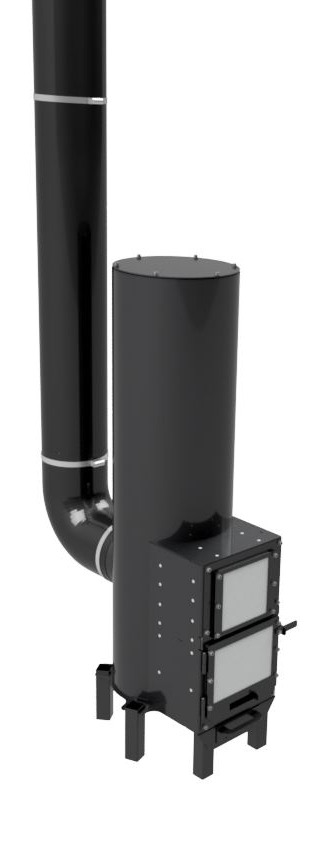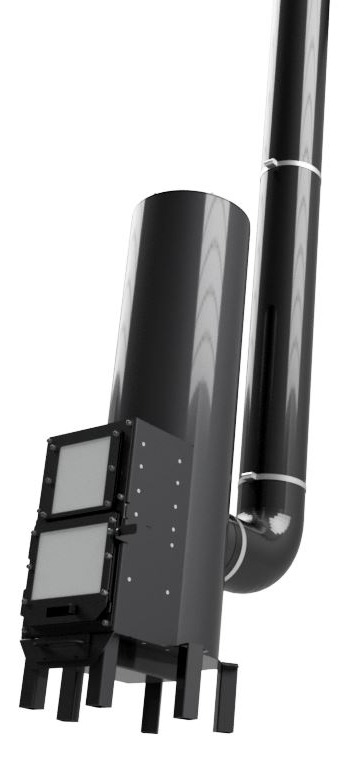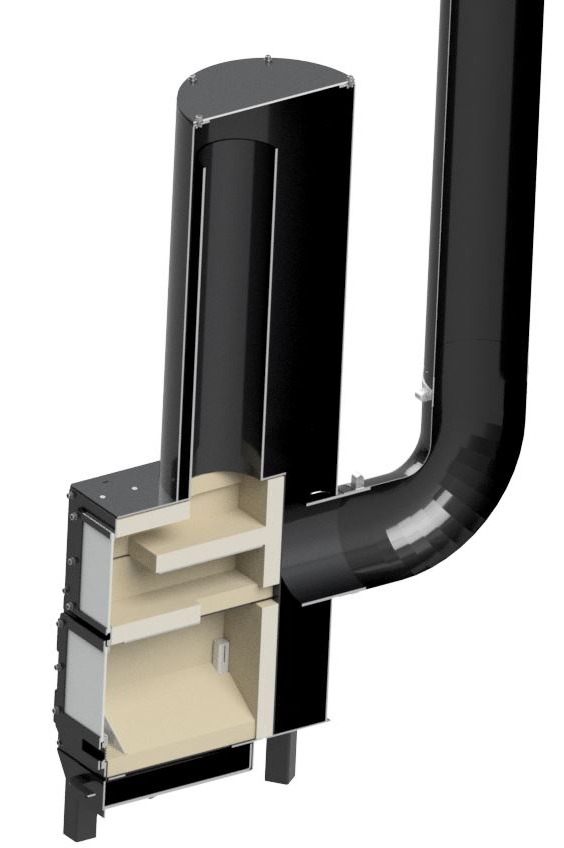|
|
Post by Vortex on Sept 11, 2021 10:51:35 GMT -8
2: If building the firebox with firebrick rather than casting, would the firebrick be set in mortar, or could it be dry stacked as well? If you cannot get castable and have to use firebrick splits to line the firebox and dont want to use mortar, this looks like it could be a good way to hold them in place. With a hand grinder and a worn disk, grind a small groove into both surfaces and place a coin in the gap. It must be loose enough so the thermal expansion cannot crack it of course. Could probably do the same with a drill and some small pieces of steel bar.  |
|
p1
New Member

Posts: 8
|
Post by p1 on Sept 11, 2021 12:15:06 GMT -8
Hi martyn,
I hadn't considered the porosity of concrete bricks, so thanks for bringing that up. I definitely want to have the option of easily dismantling the stove, so pouring concrete would be okay only if it was done in manageable pieces. But it may come to that depending on what I'm able to source. I will have to get some type of castable for the sloping floor of the firebox.
Some might consider my area to be remote, I did before I moved here. But it's actually on a major highway route and becoming quite popular with the folks from the South end of my province. I'm a boat ride and about a 6 hour driving trip from patamos. I actually lived in his area for quite a while before moving here.
The biggest issue with getting materials is that they simply aren't used much around here, so stores don't stock them. Major industrial companies have closed their doors, mills have shut down, and covid seems to have caused problems with stores being able to get supplies.
It may come to my making a trip to the lower end of the province, not something I look forward to at all with it involving a 12 hour drive. But shipping heavy products from there to here gets very expensive, so most people here make the trip to larger cities and load up with as much as they can.
Pat
|
|
p1
New Member

Posts: 8
|
Post by p1 on Sept 11, 2021 12:35:46 GMT -8
Hi Trev,
I haven't found anything like the magnetite bricks you have there. People here use things like infrared heaters, oil filled radiators, pellet stoves are quite fashionable.....until a circuit board dies, or the power goes out and it's -30 C outside. Most scrap steel and the like was shipped out over the last several years, so there's not a lot of places to pick through. The local waste dumps are the only possibility and I've found nothing at those. The floor tiles might work, though probably a lot of space between them when stacked.
The average daily temperature here is around -15/20 C for most of the winter, with dips to -30/35 or better in Jan./Feb. The steel box stove I'm using runs 24 hours at those times, otherwise things will freeze up quite quickly.
Asking at a building supply or heating store for fondue cement will get a blank look and a suggestion to try the kitchen section of the hardware store....though I may snag a recipe for a good fondue dish. They have little knowledge of anything apart from common cement. I couldn't even get a temperature rating for the firebricks I was able to find. But, they are very dense and heavy, though somewhat fragile.
I could make the stove larger, the firebox design would still work with firebricks and a different layout to get more height. But, will the 1 1/4" firebrick then be too thin with the larger firebox? I thought with the present size that I might be getting close to where the firebox may not store enough heat to do a long burn. Using heavy firebrick seems like it would be too slow on heating up.
Concerning clearances, the stove will be at an outside wall and will have about 4" clearance to the wall which is drywall. Are the temperatures at the rear of the stove likely to be high enough to cause a problem? Should it have an insulation blanket across the rear of the stove?
Support of the mass comes to mind, I'd like the steel sheets to assist and an insulation blanket will not help that, though vermiculite boards should. The building code calls for 2" clearance for masonry chimneys, but this is a different thing and I'm unsure as to what the temperatures may be.
Lots of fun to this point, and I haven't sourced the steel yet for the sides and top. After using steel box stoves for most of my life, I look at the tiny firebox I have laid out now and wonder how it could possibly provide enough heat with the amount of wood that will fit.....and tiny wood at that, half the length of what I use now.
p.s. I've never seen anything like that method to hold bricks in place, I suppose in a pinch it would work fine. Though I wonder about the open areas with extended burns. I don't really want to use mortar, I'd rather not be constantly patching brick and dry stacking seems more durable to me.
Thanks,
Pat
|
|
|
|
Post by martyn on Sept 11, 2021 12:42:19 GMT -8
You can use vermiculite for the slopping floor pieces, i have found coating the vermiculite with water glass will toughen the surface.
If you have a ready source of vermiculite then you could see it as a consumable and replace any failing components as they appear.
|
|
p1
New Member

Posts: 8
|
Post by p1 on Sept 11, 2021 13:31:11 GMT -8
You can use vermiculite for the slopping floor pieces, i have found coating the vermiculite with water glass will toughen the surface. If you have a ready source of vermiculite then you could see it as a consumable and replace any failing components as they appear. Thanks martyn, at this point vermiculite is the only thing I've been able to source apart from firebrick splits. It still has to come from the other side of the country, but prices are good and the shipping very reasonable. The only catch is having it arrive in one piece. I have the ingredients on hand to make some sodium silicate as well. Pat |
|
|
|
Post by Vortex on Sept 12, 2021 2:02:25 GMT -8
Hi Trev, I haven't found anything like the magnetite bricks you have there. People here use things like infrared heaters, oil filled radiators, pellet stoves are quite fashionable.....until a circuit board dies, or the power goes out and it's -30 C outside. Most scrap steel and the like was shipped out over the last several years, so there's not a lot of places to pick through. The local waste dumps are the only possibility and I've found nothing at those. The floor tiles might work, though probably a lot of space between them when stacked. The average daily temperature here is around -15/20 C for most of the winter, with dips to -30/35 or better in Jan./Feb. The steel box stove I'm using runs 24 hours at those times, otherwise things will freeze up quite quickly. Asking at a building supply or heating store for fondue cement will get a blank look and a suggestion to try the kitchen section of the hardware store....though I may snag a recipe for a good fondue dish. They have little knowledge of anything apart from common cement. I couldn't even get a temperature rating for the firebricks I was able to find. But, they are very dense and heavy, though somewhat fragile. I could make the stove larger, the firebox design would still work with firebricks and a different layout to get more height. But, will the 1 1/4" firebrick then be too thin with the larger firebox? I thought with the present size that I might be getting close to where the firebox may not store enough heat to do a long burn. Using heavy firebrick seems like it would be too slow on heating up. Concerning clearances, the stove will be at an outside wall and will have about 4" clearance to the wall which is drywall. Are the temperatures at the rear of the stove likely to be high enough to cause a problem? Should it have an insulation blanket across the rear of the stove? Support of the mass comes to mind, I'd like the steel sheets to assist and an insulation blanket will not help that, though vermiculite boards should. The building code calls for 2" clearance for masonry chimneys, but this is a different thing and I'm unsure as to what the temperatures may be. Lots of fun to this point, and I haven't sourced the steel yet for the sides and top. After using steel box stoves for most of my life, I look at the tiny firebox I have laid out now and wonder how it could possibly provide enough heat with the amount of wood that will fit.....and tiny wood at that, half the length of what I use now. p.s. I've never seen anything like that method to hold bricks in place, I suppose in a pinch it would work fine. Though I wonder about the open areas with extended burns. I don't really want to use mortar, I'd rather not be constantly patching brick and dry stacking seems more durable to me. Thanks, Pat I'm guessing you're in BC? I can see some places online there with firebricks and fondue cement. In those temperatures I'd recommend the 5" or 6" depending on how well your cabin is insulated. Your still thinking in metal box stove heating, where you keep it burning constantly or freeze. With the larger size you should be able to have two burns a day in it and be comfortable. The mass stores the heat that used to go straight out the chimney and gradually releases it into the house. what size was your old metal box stove in the cabin? 1 1/4" firebox sides should be OK, I was originally going to do mine 1" with 2" insulation but switched it. 4" clearance should be no problem. I stack the firewood at the back of mine, never gets over about 120C. On my original stove I did temperature measurement over the whole stove, over a whole day: donkey32.proboards.com/post/15804/thread that should give you an idea. The 'coin joint' would have ceramic insulation behind it and the gap would very quickly fill with wood ash. The roof of my firebox just sits on top of the side walls like that and has never caused any problems, so I cant see that would either. |
|
p1
New Member

Posts: 8
|
Post by p1 on Sept 12, 2021 10:08:13 GMT -8
Hi Trev,
Yes, I'm in the Interior of BC, 100 Mile House area. It does get rather cool at times in the winter here and a good source of heat is very handy. I do tend to think in terms of steel stoves as that's all I've used. I know there are quite a few masonry heaters in the area, but I've yet to see one.
I've changed the design of the firebox to a 5", which should give plenty of heat for the cabin. It's about 30 sq. meters and decently insulated and the stove I use now will overheat the place at times. It's a Tranquility 17-VL. A shallow firebox with sideway loading and a poor primary air design. I currently use around 3 cords of pine a season, these are full 4'x8' cords.
Your search skills are far better than mine, as I've found very little online except for places on the other side of the country. I did find a company today about 3 hours away, so will check for what supplies they have and may sell to the public. Also a company in Alberta selling forge supplies and they have castable refractory. The shipping is the biggest issue, both with the cost and getting things to arrive in one piece.
The electric heaters using magnesite bricks are actually available in Canada, but I've never seen one in use or at waste dumps. Though sorting through the waste dumps is discouraged as it's all lumped into big piles and there are liability concerns.
The mass is really the only thing to figure out now, as I can build a workable firebox which will be sized for a 5" system. It looks like temps on the rear of the stove will not be a problem.
|
|
|
|
Post by Vortex on Sept 12, 2021 12:47:51 GMT -8
|
|
p1
New Member

Posts: 8
|
Post by p1 on Sept 12, 2021 16:02:54 GMT -8
Thanks Trev,
I'll call these places tomorrow, actually a local building supply carries Target products, I'll see if they can bring fondue cement in for me. I'd prefer castable as I have no grog, though I'm sure I can probably get old tiles from a local installer. Clayburn has a branch 3 1/2 hours away which is better than driving 6 hours each way to the others. Getting anything out of the ordinary here usually means a minimum 1 1/2 to 2 hour drive one way.
Old clay brick is sought after around here, I've seen none in my travels.....not that there isn't any, finding them is the trick.
Pat
|
|
|
|
Post by sanderg on Sept 20, 2021 11:21:20 GMT -8
Hi all, i am following this thread for a while now and it has inspired me to design a vortex stove on my own. The designed is based for use outside and i thought it would be nice to share. The intention of this design is that no concrete pouring is needed and can easily be constructed. I din't have the time to build it but im also curious about opinions of others, STEP + 2D drawings www.dropbox.com/sh/bcqfs4fekjmfyjs/AADhVVVBLgDQHq4xmorLgwC1a?dl=0 The stove is fully made from Stainless steel and the core is made of vermiculite which is tightened with wood screws Images:    |
|
|
|
Post by Vortex on Sept 20, 2021 14:44:35 GMT -8
Hi sanderg, Welcome to the forum. Looks like you've put a lot of work into those plans.
You say the design is for use outside, is it intended for cooking, heating or both? The design doesn't look like it would work well as a cooker, and it's a lot of work and expense for outside heating (an open fire would be a lot cheaper and more effective for that). As an inside heater for someone who cannot have a heavy stove, like in an RV for instance, then it looks like it could be a good design. The top exit might need to be farther back, I've never tried it with it so close to the afterburner. The design of the top chamber is important as it has to create the right amount of resistance for the vortex to function correctly.
Vermiculite cracks up when it gets used damp, so that could be a problem outside. I have screwed some pieces together with plasterboard screws before and they held together long enough to carry out experiments, but longer term the screws would likely crack the vermiculite board, better to make the pieces so they hold each other in place.
|
|
|
|
Post by martyn on Sept 20, 2021 20:32:50 GMT -8
Fantastic drawings though….
|
|
|
|
Post by Karl L on Sept 20, 2021 22:11:38 GMT -8
Hello Trev, I think you have put the latest drawings of the Vortex Stove at the start of this thread, and also a Sketchup drawing.
The Sketchup file requires Sketchup 18.01, and I have 17.2.xxx - which I understand is the last version that is available to use for free.
Do you know how I can open your drawing without paying for Sketchup?
Thanks!
|
|
serg247
Junior Member
  The mountain can not be conquered, it can allow it to ascend...
The mountain can not be conquered, it can allow it to ascend...
Posts: 111 
|
Post by serg247 on Sept 21, 2021 1:12:32 GMT -8
Most often, those who draw well do not understand the processes well.
|
|
|
|
Post by Vortex on Sept 21, 2021 1:39:40 GMT -8
Hi Karl, I didn't make those sketchup drawings, someone else very kindly did them, I'm not very good with it. I think if you just want to view a .skp file you can use the free sketchup viewer and that will open any file made in a previous version.
The top chamber in those sketchup drawings has been improved upon since they were made, but the developments are still ongoing, so I would recommend you read through last seasons posts to get the latest. My testo is with Testo in Germany being repaired and re-calibrated, they've had it a month so far and still no quote from them...
|
|